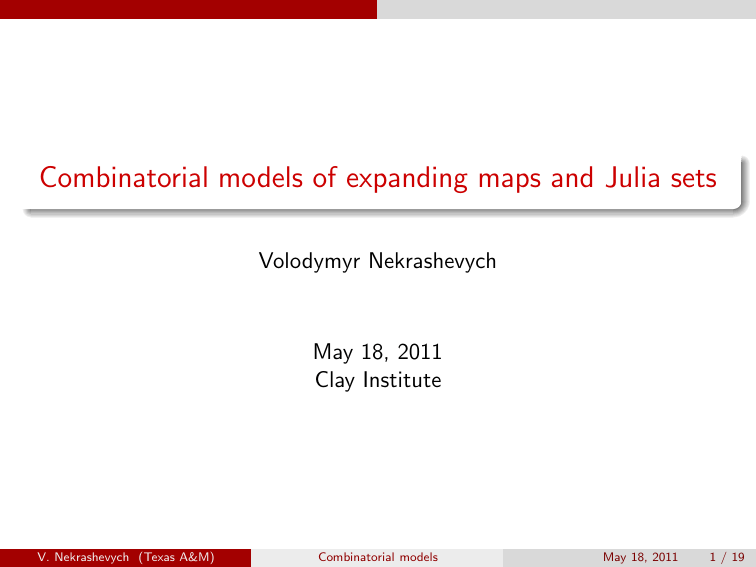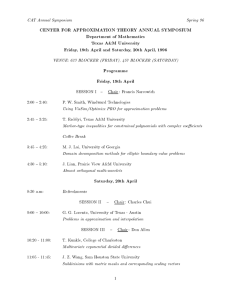Combinatorial models of expanding maps and Julia sets Volodymyr Nekrashevych Clay Institute

Combinatorial models of expanding maps and Julia sets
Volodymyr Nekrashevych
May 18, 2011
Clay Institute
V. Nekrashevych (Texas A&M)
May 18, 2011 1 / 19
Definition
A topological correspondence (topological automaton) F is a quadruple
( M , M
1
, f , ι ), where M and M
1 are topological spaces (orbispaces), f : M
1
−→ M is a finite covering map and ι : M
1
−→ M is a continuous map.
V. Nekrashevych (Texas A&M)
May 18, 2011 2 / 19
Example: −
z 3
2
+
3 z
2
V. Nekrashevych (Texas A&M)
May 18, 2011 3 / 19
Transducers
Definition
An automaton over an alphabet X is a triple ( Q , τ, π ), where Q is a set (of internal states ) and τ and π are maps
τ : Q × X −→ X , π : Q × X −→ Q , called the output and transition . The automaton is called invertible if for every q
0
∈ Q the map x 7→ τ ( q
0
, x ) is a permutation. The automaton is finite if the set Q is finite.
V. Nekrashevych (Texas A&M)
May 18, 2011 4 / 19
Dual Moore diagram
Let M be the graph with one vertex and | Q | arrows e q
, q ∈ Q . Let M
1 be the graph with the set of vertices X where for every x ∈ X and q ∈ Q we have an arrow e q
, x from x to τ ( q , x ). Define f ( e q
, x
) = e q and
ι ( e q
, x
) = e
π
( q
, x )
. If the automaton is invertible, then f is a covering.
V. Nekrashevych (Texas A&M)
May 18, 2011 5 / 19
Iterating
. . .
. . .
. . .
. ..
.
..
y f
4
−→ M
4
y f
3
−→ M
3
y f
2
−→ M
2
.
..
y f
3
−→ M
3
y f
2
−→ M
2
y f
1
−→ M
1
.
..
y f
2
−→ M
2
y f
1
−→ M
1
y f f
We get three inverse limits lim f
∞ and ∆.
F , lim
ι
F and lim f
,ι
F with self-maps ι
∞
,
V. Nekrashevych (Texas A&M)
May 18, 2011 6 / 19
Iterated monodromy groups
Let F = ( M , M
1
, f , ι ) be a topological correspondence. Identify π
1
( M
1
) with a subgroup of finite index in π
1
( M ). Then ι
∗
: π
1
( M
1
) −→ π
1
( M ) is the virtual endomorphism of π
1
( M ) associated with the correspondence.
Denote
\
N
ι
∗
= g − 1 · Dom ι n
∗
· g n ≥ 1
, g ∈
π 1
( M )
The iterated monodromy group of F is
IMG ( F ) = π
1
( M ) / N
ι
∗ together with the (conjugacy class of) the virtual endomorphism induced by ι
∗
. Two topological correspondences are combinatorially equivalent if they have the same iterated monodromy groups.
V. Nekrashevych (Texas A&M)
May 18, 2011 7 / 19
Contracting correspondences
Definition
Let F = ( M , M
1
, f , ι ) be a topological correspondence such that M is a compact path connected and locally path connected (orbi)space.
F is contracting if there exists a length structure on M and λ < 1 such that for every rectifiable path γ in M
1 length( ι ( γ )) ≤ λ · length( γ ) , where length of γ is computed with respect the lift of the length structure by f .
V. Nekrashevych (Texas A&M)
May 18, 2011 8 / 19
Rigidity Theorem
Theorem
Let F = ( M , M
1
, f , ι ) be a contracting topological correspondence with locally simply connected M . Then the system (lim
ι
F , f
∞
) depends, up to a topological conjugacy, on ( IMG ( F ) , ι
∗
) only.
f
If F is a correspondence associated with an expanding partial self-covering
: M
1
−→ M , then F is contracting, and the limit (lim
ι
F , f
∞
) is restriction of f onto the attractor T n ≥ 0
M n of backward iterations of
(the “Julia set” of f ). Constructing another combinatorially equivalent f contracting topological correspondence F , we get approximations of the
Julia set.
V. Nekrashevych (Texas A&M)
May 18, 2011 9 / 19
A multi-dimensional example
Consider the following map C n −→ C n :
F ( x
1
, x
2
, . . . , x n
) = 1 −
1 x 2 n
, 1 − x 2
1 x 2 n
, . . . , 1 − x
2 n − 1 x 2 n
!
.
It can be extended to an endomorphism of CP n :
[ x
1
: x
2
: · · · : x n
: x n +1
] 7→ [ x
2 n
− x
2 n +1
: x
2 n
− x
2
1
: · · · : x
2 n
− x
2 n − 1
: x
2 n
] .
The union of the forward orbits of the set of critical points is the union P of the hyperplanes x i
F : CP n \ F − 1 ( P ) −→
= 0,
CP n x i
=
\ P .
x j
. We get a partial self-covering
V. Nekrashevych (Texas A&M)
May 18, 2011 10 / 19
A model of
F
A cactus diagram is an oriented two-dimensional contractible cellular complex Γ consisting of n + 2 discs D i
, i = 0 , 1 , . . . , n , n + 1, such that any two disc are either disjoint or have only one common point. A planar cactus diagram is a cactus diagram Γ together with an isotopy class of an orientation preserving embedding ∆ : Γ −→ R
2 (i.e., cyclic orders of the discs adjacent to every given disc). A metric cactus diagram is a cactus of the disc D k is n
√
2 − k .
Let M be the space of all such metric planar cactus diagrams. It is an affine polyhedral complex. The cells are in a bijective correspondence with planar cactus diagrams.
V. Nekrashevych (Texas A&M)
May 18, 2011 11 / 19
V. Nekrashevych (Texas A&M)
May 18, 2011 12 / 19
V. Nekrashevych (Texas A&M)
May 18, 2011 13 / 19
For every planar metric cactus diagram Γ consider a diagram Γ
1 such that there exists a degree two branched covering map Γ point inside the disc D
0
1
−→ Γ with the critical
. Denote one of the preimages of D i by D 0 i − 1
(mod n + 2). Let M
1 be the configuration space of such labeled planar metric cactus diagrams Γ
For Γ
1
∈ M
1
1 all the distances by
. We have a natural covering map f : Γ
1 contract the non-labeled discs, rename n
D i
0 by
7→
D i
Γ.
and divide
2. You get a point of M . This gives the map
ι : M
1
−→ M .
V. Nekrashevych (Texas A&M)
May 18, 2011 14 / 19
V. Nekrashevych (Texas A&M)
May 18, 2011 15 / 19
Julia set of 1 −
x
1
2
V. Nekrashevych (Texas A&M)
May 18, 2011 16 / 19
V. Nekrashevych (Texas A&M)
May 18, 2011 17 / 19
General approach
Let φ : G
1
−→ G be a surjective virtual endomorphism of a finitely generated group. If X is space with a co-compact proper G -action by isometries and F : X −→ X is such that
F ( x · g ) = F ( x ) · φ ( g ) .
Then ( M = X / G , M
1
= X / G
1
, f , ι ), where f , ι are induced by identity and F , is a topological correspondence with the associated virtual endomorphism φ .
Let S = S − 1 3 1 be a finite generating set of G .
Rips complex Γ( G , S n ) is the simplicial complex with set of vertices G where A is a simplex if
Ag − 1 ⊂ S n for all g ∈ A .
V. Nekrashevych (Texas A&M)
May 18, 2011 18 / 19
Let φ : G
1
−→ G be a contracting surjective virtual endomorphism.
Choose a left coset representative system { g
1
, g
2
, . . . , g d
} of G / G
1
. Define
F ( g ) = φ ( g i
− 1 g ). Then F ( x · g ) = F ( x ) · φ ( g ) for all x ∈ G and g ∈ Dom φ .
Theorem
There exist n and m such that F m : Γ( G , S n ) −→ Γ( G , S and equivariantly homotopic to a contracting map.
n ) is simplicial
Here equivariant homotopy means that H ( x · g ) = H ( x ) · φ ( g ) for all maps
H along the homotopy.
V. Nekrashevych (Texas A&M)
May 18, 2011 19 / 19
